Essential Tackle for Ice Fishing Success
The frozen world of ice fishing offers a unique and rewarding winter outdoor experience. Unlike open-water fishing, ice fishing requires specialized equipment designed to withstand frigid temperatures while helping anglers effectively target fish beneath the ice. Whether you’re a beginner venturing onto frozen waters for the first time or a seasoned ice angler looking to optimize your setup, having the right gear can make the difference between a frustrating outing and a productive day on the ice.
This comprehensive guide explores the essential tackle and equipment you’ll need to increase your chances of ice fishing success while staying safe and comfortable in winter conditions.
Ice Augers: Your Gateway Through the Frozen Surface
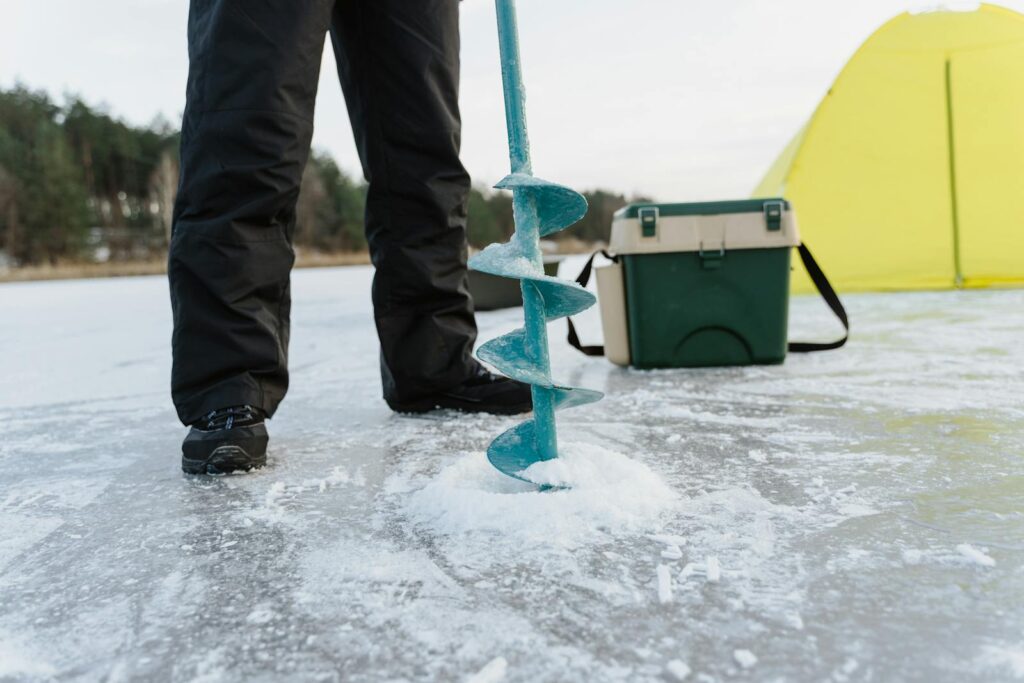
Ice augers are perhaps the most fundamental piece of equipment for ice fishing, as they create the hole through which you’ll fish. Manual hand augers are affordable and lightweight options ideal for thinner ice conditions and anglers who fish close to access points. Power augers, which run on gas, propane, or battery power, drill through thick ice much faster and with less physical effort, making them preferable for frequent anglers or those fishing multiple locations. Electric models have gained popularity in recent years due to their quiet operation, lack of fumes, and impressive battery life that can drill dozens of holes on a single charge.
When selecting an auger, consider the typical ice thickness in your region, how many holes you’ll drill in a day, and how far you’ll need to transport it across the ice.
Ice Fishing Rods: Specialized Design for Vertical Jigging

Ice fishing rods differ significantly from their open-water counterparts, featuring much shorter lengths typically ranging from 24-36 inches to facilitate fishing in confined spaces. These compact rods are designed specifically for the vertical jigging technique predominant in ice fishing, with sensitive tips that telegraph the often-subtle bites common beneath the ice. Ultra-light and light action rods are preferred for panfish like crappie, perch, and bluegill, while medium to medium-heavy actions are better suited for larger species such as pike, walleye, and lake trout.
Many quality ice rods feature spring bobbers or strike indicators at the tip, which enhance bite detection when fish are particularly finicky during winter months. Modern ice rods often incorporate specialized handles with built-in reel seats designed to provide good grip even when wearing gloves or mittens.
Ice Fishing Reels: Compact Power and Smooth Performance
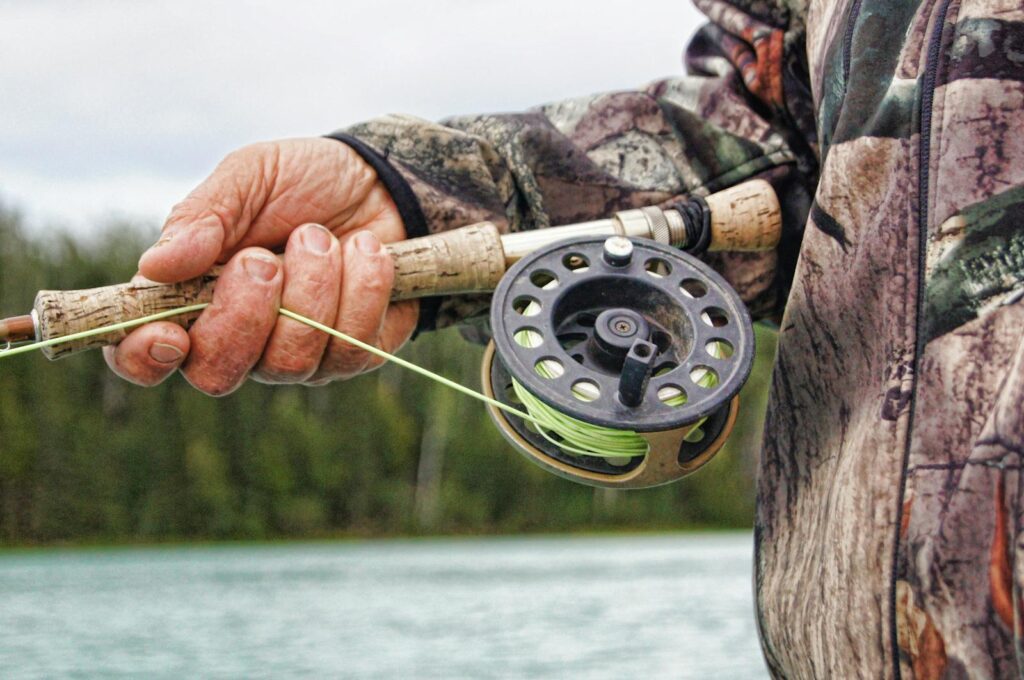
The ideal ice fishing reel balances lightweight design with smooth drag performance that can handle struggling fish in cold conditions. Small spinning reels (sizes 500-1000) are the most versatile option, offering good line capacity while remaining compact enough for ice fishing applications. Inline reels have gained popularity among serious ice anglers because they eliminate line twist and reduce ice buildup on the spool and line guides. When selecting a reel, look for models with smooth drag systems that remain responsive even in subzero temperatures, as cold can affect the performance of lower-quality drag components.
Premium ice fishing reels feature sealed drag systems that prevent water intrusion and freezing, along with oversized handles that are easier to operate while wearing gloves. For ultra-light presentations targeting panfish, some anglers prefer straight-line reels that mimic fly fishing reels in their operation.
Line Selection: Critical Considerations for Cold Water
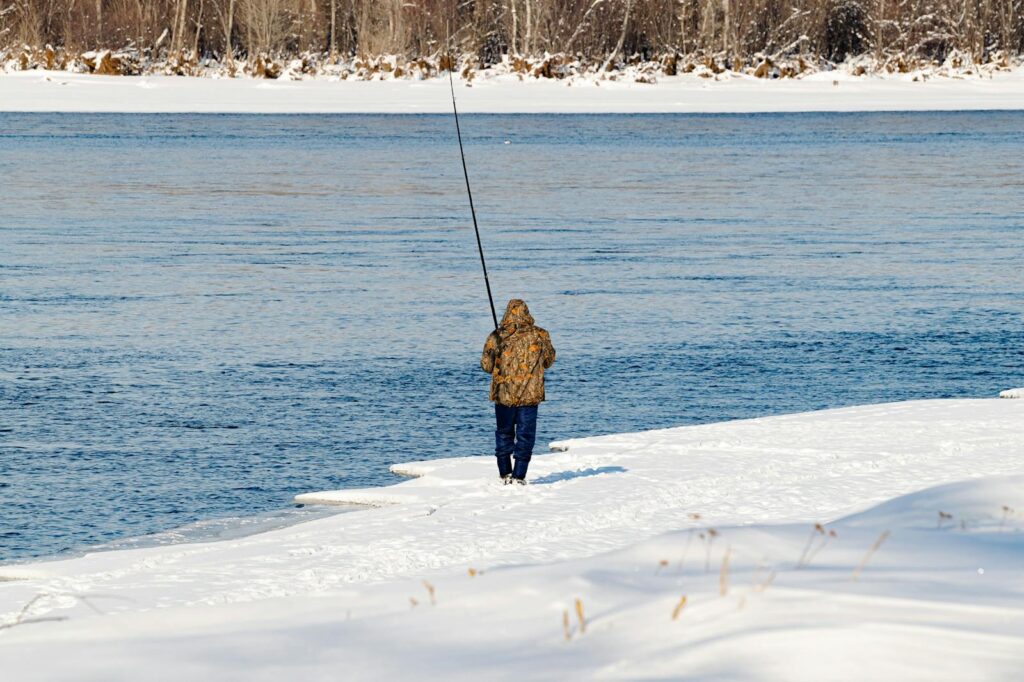
Fishing line performance changes dramatically in cold water, making proper line selection crucial for ice fishing success. Monofilament becomes stiff and prone to memory issues in frigid temperatures, though some specialized “ice mono” formulations address these concerns. Fluorocarbon line offers excellent abrasion resistance and near invisibility underwater, making it ideal as leader material, though it can be somewhat stiff in very cold conditions. Many experienced ice anglers prefer braided line with a fluorocarbon leader, as quality braids maintain flexibility in cold temperatures while providing excellent sensitivity to detect light bites.
Line diameter is especially important in ice fishing, as smaller diameter lines cut through water more easily during the vertical presentation and create less line drag. For panfish, 2-4 pound test is standard, while walleye and bass typically require 6-8 pound test, and pike or lake trout setups might use 10-15 pound test or heavier.
Lures and Baits: Specialized Offerings for Winter Fish
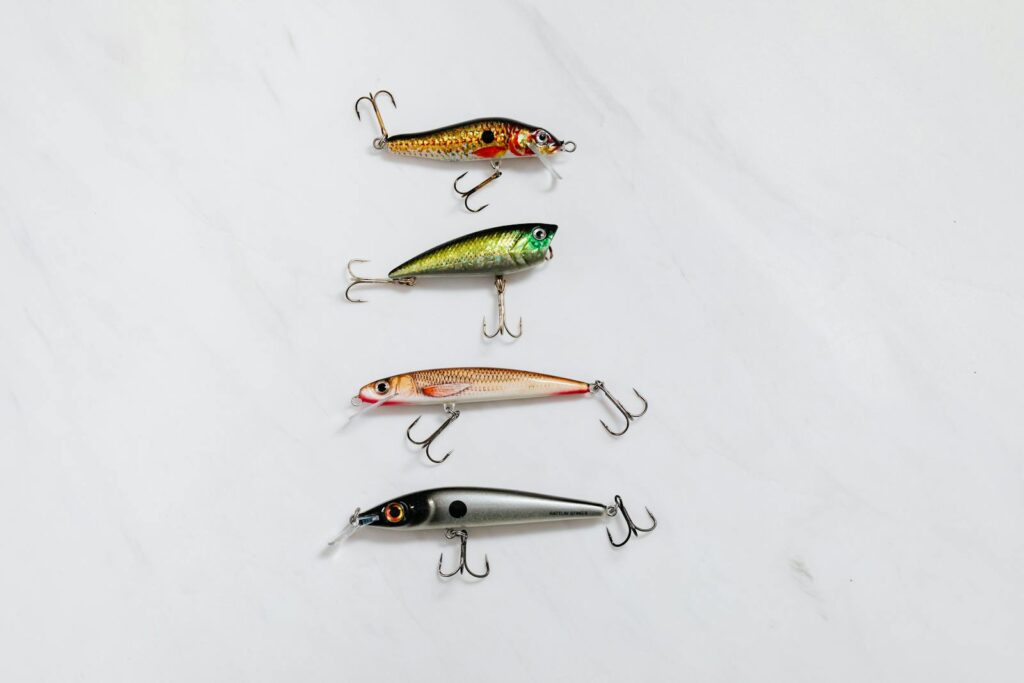
Winter fish typically have slower metabolisms and require presentations that trigger reaction strikes or appeal to their more selective feeding habits. Tungsten jigs have revolutionized ice fishing due to their smaller profile yet heavier weight compared to lead, allowing for faster sink rates and better sensitivity. Small spoons like Swedish Pimples, Kastmasters, and Slender Spoons provide flash and vibration that attract fish from distance, working well for active jigging presentations. Soft plastic baits designed specifically for ice fishing, such as micro tubes, tiny minnow imitations, and insect larvae replicas, often outperform standard soft plastics due to their specialized formulations that remain flexible in cold water.
Live bait remains exceptionally effective for ice fishing, with maggots, waxworms, and minnows being the standard offerings depending on target species. Many successful ice anglers employ a “deadstick” approach with one rod, using live bait set motionless while actively jigging artificial lures with another rod.
Electronics: Finding Fish Through the Ice
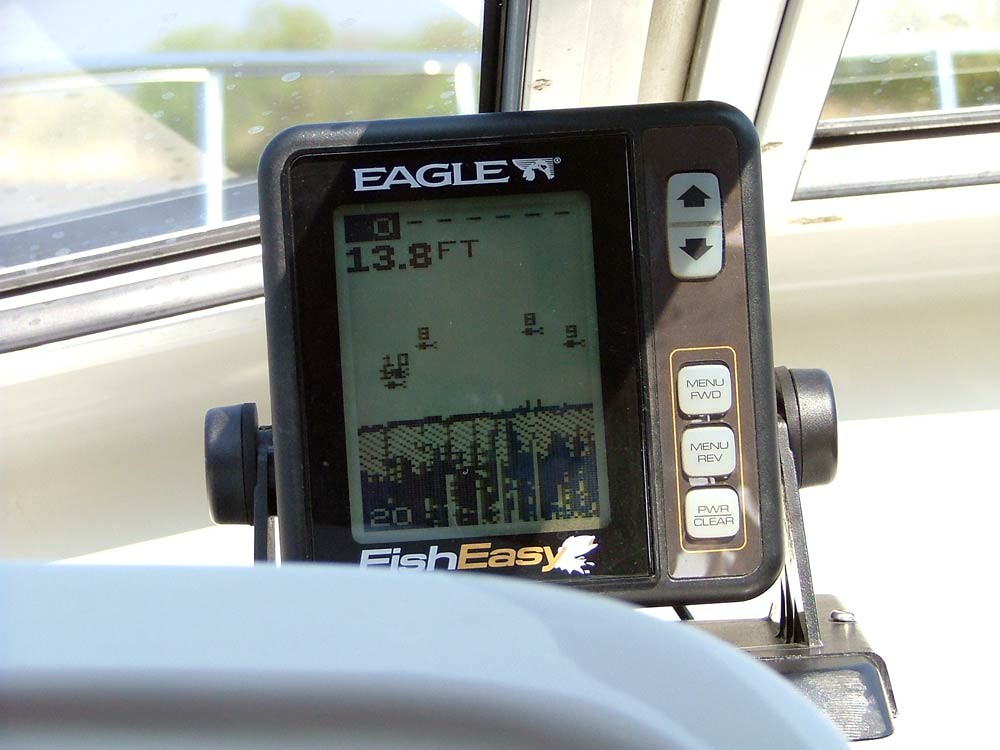
Modern electronics have transformed ice fishing from a game of chance to a targeted pursuit. Flashers represent the traditional electronic tool for ice fishing, providing real-time sonar readings that display your lure and approaching fish with remarkable accuracy. More advanced LCD fish finders designed specifically for ice fishing offer detailed views of bottom structure and fish location, often with GPS functionality that allows marking productive spots for return visits. Some cutting-edge units offer side-imaging capabilities that allow scanning beneath the ice to locate fish before drilling holes.
Underwater cameras have become increasingly affordable and provide an actual view of fish behavior and bottom composition, which can be invaluable for understanding how fish are reacting to your presentations. For serious ice anglers, combining multiple technologies—perhaps using a flasher for active jigging and an underwater camera for studying fish behavior—creates the most complete picture of the underwater environment.
Ice Shelters: Protection from the Elements

Ice shelters dramatically enhance comfort during cold, windy, or snowy conditions, extending fishing time and improving concentration by keeping anglers protected from harsh elements. Flip-over shelters function like mobile ice fishing sleds that convert into instant one or two-person shelters, making them ideal for run-and-gun fishing when you’re frequently changing locations. Hub-style shelters offer more interior space and typically accommodate multiple anglers, though they take longer to set up and take down compared to flip-style shelters. Insulated shelters significantly reduce heat loss and prevent condensation issues, while non-insulated models are lighter and more portable but require more heating.
For extended fishing sessions or particularly harsh conditions, permanent or semi-permanent shanties provide maximum comfort with features like bench seating, multiple fishing holes, and sometimes even sleeping accommodations. Many ice anglers find that a portable propane heater inside their shelter makes even the coldest days comfortable, though proper ventilation is essential for safety.
Transportation and Storage Solutions
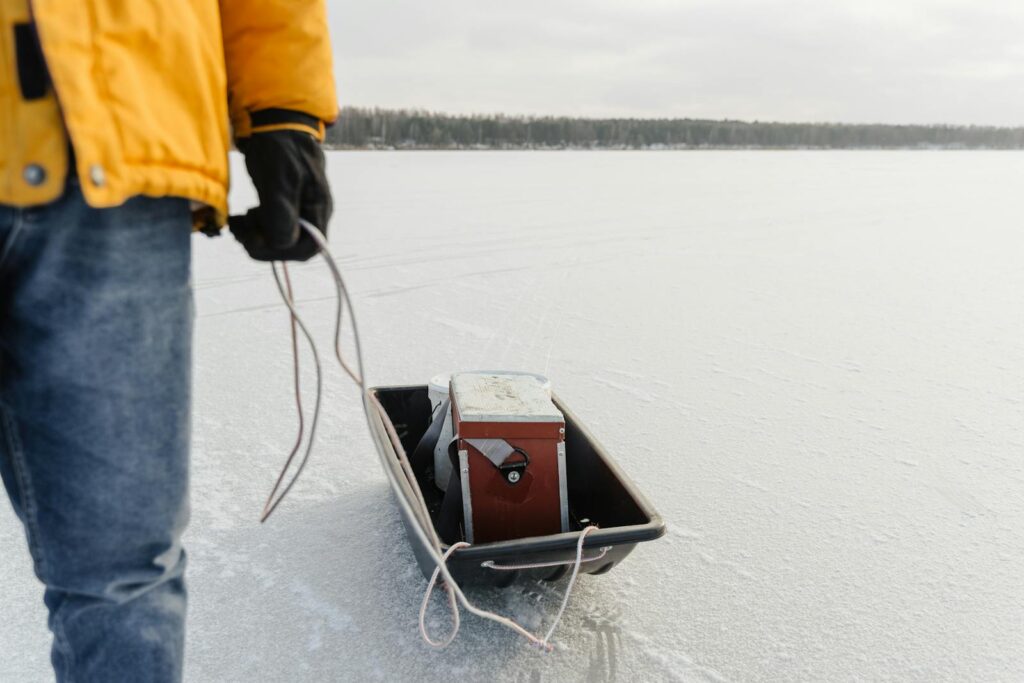
Efficiently transporting and organizing gear across the ice is crucial for a successful outing. Ice sleds are the most basic transportation option, providing a platform to pull equipment across the ice with less effort than carrying everything. Specialized ice fishing sleds feature molded compartments for organization, hitching points for easy towing, and sometimes integrated seating. For covering greater distances, many anglers employ snowmobiles or ATVs equipped with ice-specific accessories such as auger holders and rod storage systems.
Once on the ice, tackle management becomes critical, with many ice anglers utilizing specialized boxes that feature compartments sized appropriately for small jigs and compact lures. Bucket organizers that fit standard 5-gallon buckets have become popular, offering tiered storage while doubling as seating. Rod cases protect delicate ice rods during transport and storage, while insulated bait containers keep live bait from freezing during frigid outings.
Ice Safety Equipment: Non-Negotiable Essentials

Safety equipment should be considered mandatory tackle for responsible ice fishing. Ice picks or spikes, worn around the neck, provide crucial self-rescue capability if you break through the ice, allowing you to grip the ice surface and pull yourself out. A floating safety rope can extend rescue capabilities to help others or allow someone to assist you in an emergency situation. Ice chisels or spud bars help test ice thickness as you venture out, with experienced anglers tapping ahead to verify safe ice before proceeding. Personal flotation devices designed for ice fishing provide crucial buoyancy while allowing full range of movement for fishing activities.
A set of spare dry clothes kept in a waterproof container in your vehicle can be lifesaving if you get wet, while ice cleats attached to boots prevent dangerous falls on slippery surfaces. Many experienced ice anglers also carry emergency communication devices like waterproof two-way radios or satellite messengers, especially when fishing remote locations.
Clothing and Personal Comfort Items

Proper clothing for ice fishing follows the tried-and-true layering principle, starting with moisture-wicking base layers that keep perspiration away from the skin. Insulating mid-layers made of fleece or wool provide crucial warmth while maintaining breathability to prevent overheating during active periods. Outer layers should be both windproof and waterproof, with ice-specific fishing suits or bibs offering reinforced knees for kneeling on ice and additional insulation in the seat area. Extremity protection deserves special attention, with waterproof, insulated boots rated for subzero temperatures being essential, along with thermal socks that maintain warmth even when compressed inside tight-fitting boots.
Hand protection typically involves a system of thin liner gloves for dexterity when handling tackle, covered by heavily insulated mittens that can be quickly removed when needed. Head protection should include insulated hats that cover the ears, and many anglers add face masks or balaclavas during particularly cold or windy conditions to prevent frostbite on exposed facial skin.
Specialized Ice Fishing Accessories
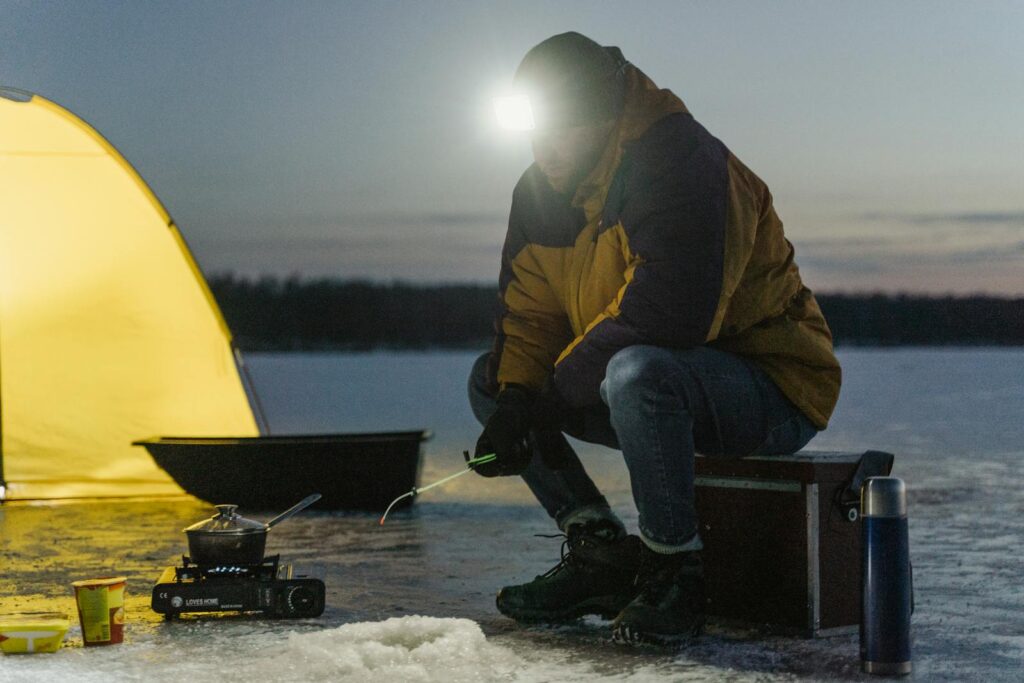
A collection of specialized accessories can significantly enhance the ice fishing experience. Ice scoops remove slush and ice chips from holes, keeping them fishable and preventing line freezing. Tip-ups are automated flag systems that allow passive fishing with live bait while you actively jig elsewhere, essentially multiplying your fishing coverage. Rod holders secure rods in position for deadsticking presentations or when you need both hands free. Portable LED lights extend fishing into dawn, dusk, or nighttime hours when fish are often most active during winter.
Retractable measuring tools allow quick length verification for regulation compliance without exposing hands to cold water for extended periods. Specialized hook disgorgers and long-nose pliers make hook removal safer for both angler and fish in freezing conditions. Many ice anglers also carry small towels dedicated to wiping down wet lures and equipment, preventing ice buildup that can impair functionality.
Considerations for Mobility vs. Comfort
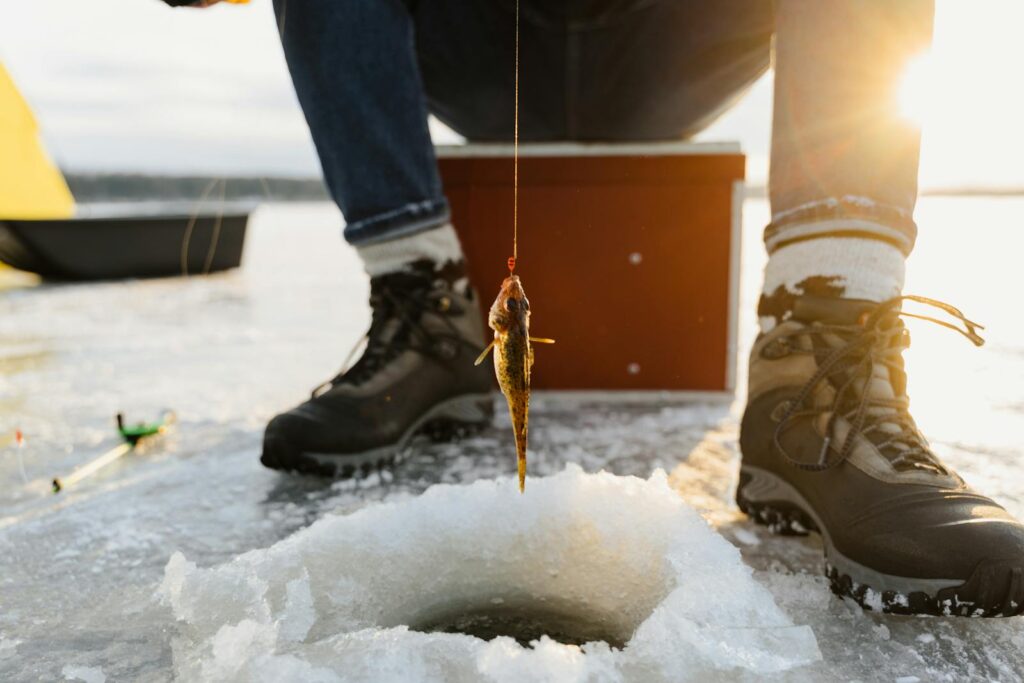
Every ice angler must balance mobility against comfort, with this decision significantly influencing tackle selection. Run-and-gun anglers prioritize lightweight, portable equipment that allows covering substantial distance to locate active fish, often sacrificing some comfort for mobility. This approach typically involves lightweight hand augers, minimal electronics, compact rod cases, and either no shelter or a lightweight flip-style option. Stationary anglers emphasize comfort for extended fishing sessions in one location, utilizing heavier but more feature-rich equipment like power augers, larger shelters, heaters, and comprehensive electronics.
Many experienced ice anglers develop hybrid approaches that vary by conditions—perhaps using mobile setups during early season when fish are often scattered, then transitioning to comfort-focused setups during mid-winter when fish establish more predictable patterns. Weather conditions also influence this balance, with harsh conditions pushing even mobility-focused anglers toward shelter-based approaches. The most versatile ice fishing systems allow adapting to changing conditions, with modular components that can be added or removed as situations warrant.
Budget Considerations and Prioritizing Purchases
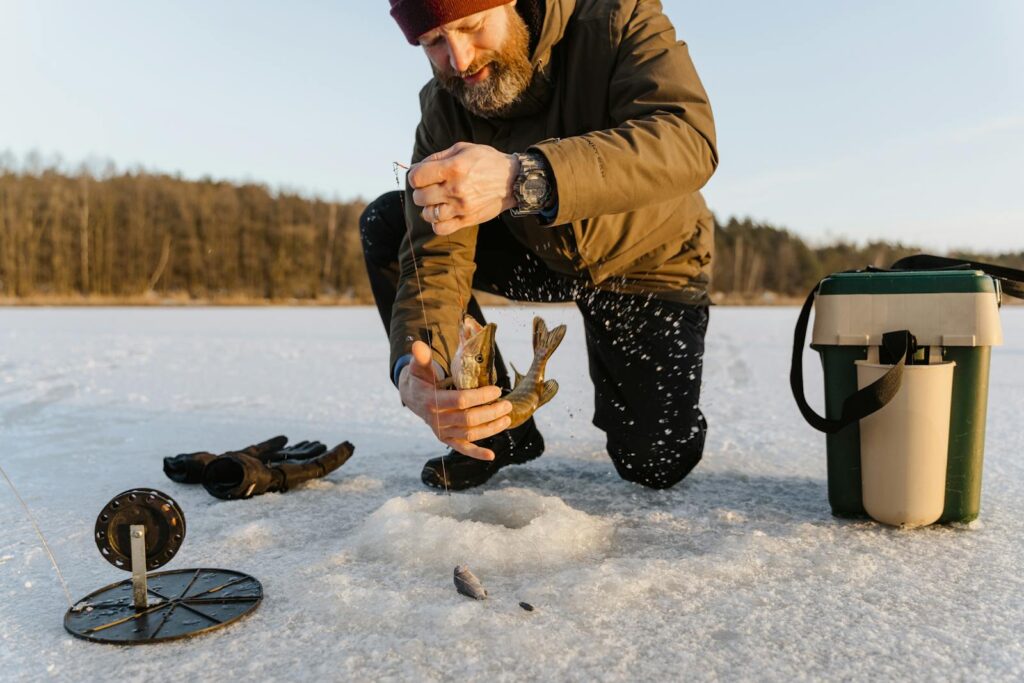
Building a complete ice fishing tackle collection represents a significant investment, making strategic purchasing decisions important. Quality ice rods and reels should be among the first investments, as they directly influence your ability to detect bites and successfully land fish. Safety equipment represents non-negotiable early purchases, regardless of budget constraints, as no fishing success is worth risking safety on the ice. For those with limited budgets, manual augers offer affordable entry points that perform adequately in most conditions without the expense of power options. Used equipment markets offer excellent value, particularly for shelters and electronics, where previous-generation models often provide most functionality at substantial discounts.
Many anglers prioritize comfort items like shelters and heaters only after establishing their basic fishing capability, though in extremely cold regions, these might become higher priorities. When possible, borrowing or renting specialized equipment for initial outings allows testing before committing to purchases, helping identify which items provide the most value for your specific fishing style and local conditions.
Conclusion

The world of ice fishing tackle continues to evolve with technological advances creating more efficient, comfortable, and productive options for winter anglers. While the essential categories remain consistent—augers, rods, reels, shelters, and safety equipment—the specific choices within each category should reflect your fishing style, target species, local conditions, and budget considerations. By thoughtfully assembling your ice fishing tackle collection with emphasis on versatility and quality in the most critical components, you’ll enhance both safety and success during winter fishing expeditions.
Remember that even the most advanced equipment serves only to complement—never replace—the knowledge, patience, and experience that ultimately define successful ice anglers. As you build your ice fishing system, focus first on fundamentals, then gradually add specialized items that address specific challenges or opportunities in your ice fishing environment.














Post Comment